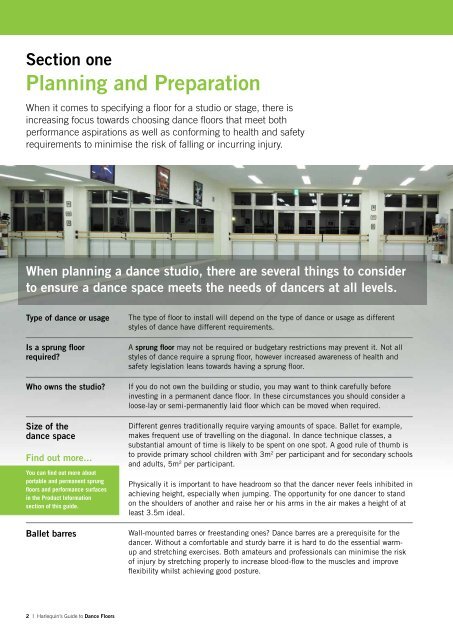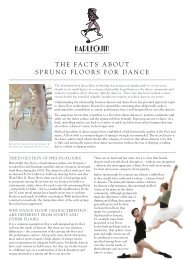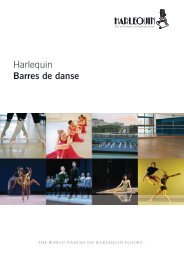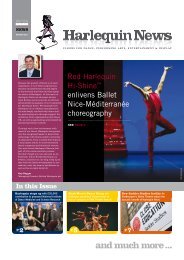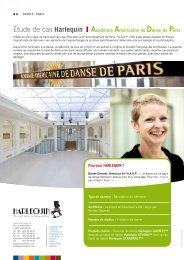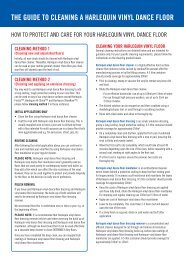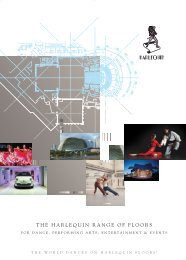Harlequin's Guide to Dance Floors - Harlequin Floors
Harlequin's Guide to Dance Floors - Harlequin Floors
Harlequin's Guide to Dance Floors - Harlequin Floors
You also want an ePaper? Increase the reach of your titles
YUMPU automatically turns print PDFs into web optimized ePapers that Google loves.
Section one<br />
Planning and Preparation<br />
When it comes <strong>to</strong> specifying a floor for a studio or stage, there is<br />
increasing focus <strong>to</strong>wards choosing dance floors that meet both<br />
performance aspirations as well as conforming <strong>to</strong> health and safety<br />
requirements <strong>to</strong> minimise the risk of falling or incurring injury.<br />
When planning a dance studio, there are several things <strong>to</strong> consider<br />
<strong>to</strong> ensure a dance space meets the needs of dancers at all levels.<br />
Type of dance or usage<br />
Is a sprung floor<br />
required?<br />
Who owns the studio?<br />
Size of the<br />
dance space<br />
Find out more...<br />
You can find out more about<br />
portable and permanent sprung<br />
floors and performance surfaces<br />
in the Product Information<br />
section of this guide.<br />
Ballet barres<br />
The type of floor <strong>to</strong> install will depend on the type of dance or usage as different<br />
styles of dance have different requirements.<br />
A sprung floor may not be required or budgetary restrictions may prevent it. Not all<br />
styles of dance require a sprung floor, however increased awareness of health and<br />
safety legislation leans <strong>to</strong>wards having a sprung floor.<br />
If you do not own the building or studio, you may want <strong>to</strong> think carefully before<br />
investing in a permanent dance floor. In these circumstances you should consider a<br />
loose-lay or semi-permanently laid floor which can be moved when required.<br />
Different genres traditionally require varying amounts of space. Ballet for example,<br />
makes frequent use of travelling on the diagonal. In dance technique classes, a<br />
substantial amount of time is likely <strong>to</strong> be spent on one spot. A good rule of thumb is<br />
<strong>to</strong> provide primary school children with 3m 2 per participant and for secondary schools<br />
and adults, 5m 2 per participant.<br />
Physically it is important <strong>to</strong> have headroom so that the dancer never feels inhibited in<br />
achieving height, especially when jumping. The opportunity for one dancer <strong>to</strong> stand<br />
on the shoulders of another and raise her or his arms in the air makes a height of at<br />
least 3.5m ideal.<br />
Wall-mounted barres or freestanding ones? <strong>Dance</strong> barres are a prerequisite for the<br />
dancer. Without a comfortable and sturdy barre it is hard <strong>to</strong> do the essential warmup<br />
and stretching exercises. Both amateurs and professionals can minimise the risk<br />
of injury by stretching properly <strong>to</strong> increase blood-flow <strong>to</strong> the muscles and improve<br />
flexibility whilst achieving good posture.<br />
2 I <strong>Harlequin</strong>’s <strong>Guide</strong> <strong>to</strong> <strong>Dance</strong> <strong>Floors</strong>


